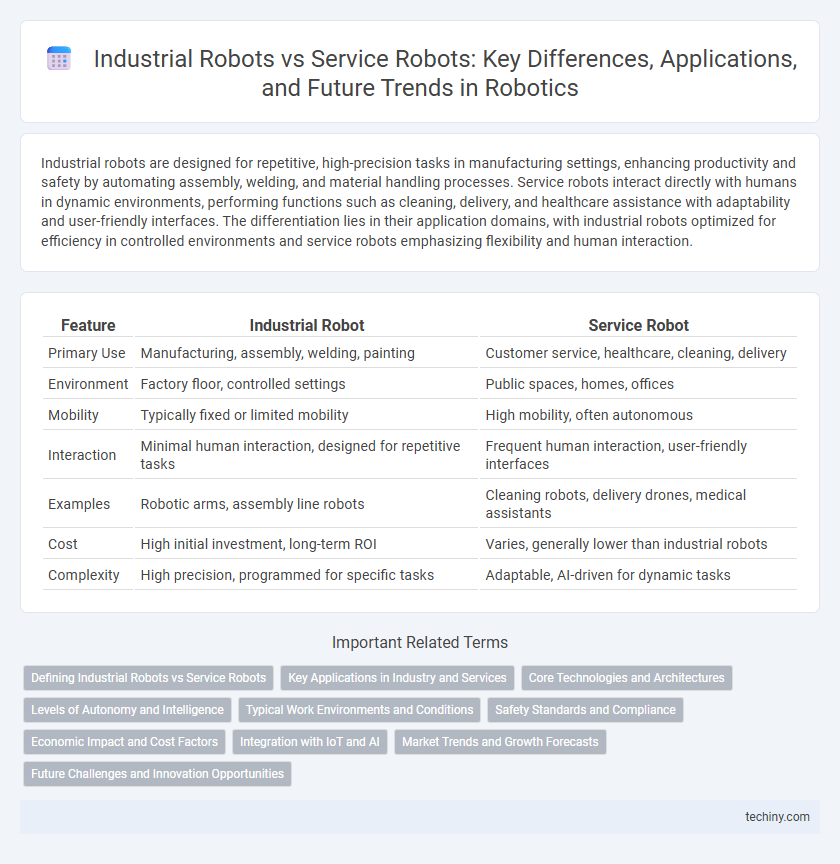Industrial robots are designed for repetitive, high-precision tasks in manufacturing settings, enhancing productivity and safety by automating assembly, welding, and material handling processes. Service robots interact directly with humans in dynamic environments, performing functions such as cleaning, delivery, and healthcare assistance with adaptability and user-friendly interfaces. The differentiation lies in their application domains, with industrial robots optimized for efficiency in controlled environments and service robots emphasizing flexibility and human interaction.
Table of Comparison
| Feature | Industrial Robot | Service Robot |
|---|---|---|
| Primary Use | Manufacturing, assembly, welding, painting | Customer service, healthcare, cleaning, delivery |
| Environment | Factory floor, controlled settings | Public spaces, homes, offices |
| Mobility | Typically fixed or limited mobility | High mobility, often autonomous |
| Interaction | Minimal human interaction, designed for repetitive tasks | Frequent human interaction, user-friendly interfaces |
| Examples | Robotic arms, assembly line robots | Cleaning robots, delivery drones, medical assistants |
| Cost | High initial investment, long-term ROI | Varies, generally lower than industrial robots |
| Complexity | High precision, programmed for specific tasks | Adaptable, AI-driven for dynamic tasks |
Defining Industrial Robots vs Service Robots
Industrial robots are automated, programmable machines primarily used in manufacturing environments for tasks such as welding, assembly, and material handling, characterized by high precision and durability. Service robots perform tasks that assist humans outside industrial settings, including healthcare, cleaning, and customer service, emphasizing interaction and adaptability. The key distinction lies in their application domains and the complexity of human-robot interaction, with industrial robots optimized for repetitive, high-load operations and service robots designed for dynamic environments requiring sensory and cognitive capabilities.
Key Applications in Industry and Services
Industrial robots are primarily used for manufacturing tasks such as welding, assembly, painting, and material handling, significantly increasing production efficiency and precision. Service robots operate in sectors like healthcare, logistics, and customer service, performing tasks including surgery assistance, package delivery, and cleaning. Both types integrate advanced sensors and AI to adapt to dynamic environments, enhancing operational productivity across industries.
Core Technologies and Architectures
Industrial robots primarily rely on rigid mechanical architectures, high-precision actuators, and sensor fusion technologies to perform repetitive, high-load tasks in controlled environments. Service robots incorporate advanced AI algorithms, flexible architectures, and multimodal sensor integration to navigate dynamic, unstructured settings and interact safely with humans. Both leverage core technologies such as machine vision, motion planning, and real-time control, yet differ significantly in adaptability and application-specific design.
Levels of Autonomy and Intelligence
Industrial robots typically exhibit high levels of autonomy with pre-programmed tasks and limited environmental adaptation, relying on fixed automation and precise repeatability. Service robots often incorporate advanced intelligence through machine learning, sensor fusion, and adaptive decision-making to perform varied and dynamic tasks in unstructured environments. The distinction lies in industrial robots' deterministic control systems versus service robots' cognitive capabilities enabling real-time interaction and autonomous problem solving.
Typical Work Environments and Conditions
Industrial robots operate primarily in controlled environments such as manufacturing assembly lines, automotive factories, and electronics production facilities, where conditions are often structured for repetitive, precise tasks. Service robots function in dynamic, unstructured settings including hospitals, homes, and outdoor locations, adapting to variable conditions and human interaction. The typical industrial robot workspace emphasizes durability and speed under consistent conditions, while service robots prioritize flexibility and safety in unpredictable environments.
Safety Standards and Compliance
Industrial robots are subject to stringent safety standards such as ISO 10218 and ANSI/RIA R15.06, ensuring risk assessments and protective measures during operation in manufacturing environments. Service robots adhere to different compliance frameworks like ISO 13482, focusing on safe human-robot interaction in non-industrial settings, with emphasis on minimizing hazards in public or domestic spaces. Both categories require rigorous certification processes to meet regional and international safety regulations, reflecting their distinct operational contexts.
Economic Impact and Cost Factors
Industrial robots drive significant economic growth by enhancing manufacturing productivity, reducing labor costs, and minimizing operational errors, making them essential in automotive and electronics industries. Service robots, while often more expensive upfront due to advanced sensors and AI integration, provide cost savings in sectors like healthcare and logistics through automation of repetitive or hazardous tasks. The total cost of ownership for industrial robots is generally lower over time, attributed to high-volume production efficiencies and longer operational lifespans compared to the specialized and flexible design requirements of service robots.
Integration with IoT and AI
Industrial robots extensively leverage IoT and AI for real-time data analytics, predictive maintenance, and automation optimization, enhancing manufacturing precision and efficiency. Service robots integrate AI-driven natural language processing and IoT connectivity to improve human-robot interaction and adapt to dynamic environments in healthcare, logistics, and customer service sectors. The seamless fusion of IoT sensors and AI algorithms enables both robot types to perform complex tasks autonomously while ensuring adaptive learning and operational reliability.
Market Trends and Growth Forecasts
Industrial robots dominate manufacturing sectors with a projected CAGR of 9.5% from 2024 to 2030, driven by automation in automotive and electronics industries. Service robots, including cleaning, healthcare, and logistics units, are expanding rapidly with an expected CAGR of 15%, fueled by increased demand for automation in non-industrial environments. Market trends highlight industrial robots' steady growth in production efficiency, while service robots benefit from innovations in AI and IoT enabling broader applications and customer acceptance.
Future Challenges and Innovation Opportunities
Industrial robots face future challenges in enhancing adaptability and integrating AI for complex tasks, driving innovation in advanced sensory systems and machine learning algorithms. Service robots require breakthroughs in human-robot interaction, autonomous decision-making, and safety protocols to operate seamlessly in dynamic environments. Both sectors present opportunities to leverage edge computing and collaborative robotics to increase efficiency and broaden application scopes.
Industrial robot vs service robot Infographic

 techiny.com
techiny.com